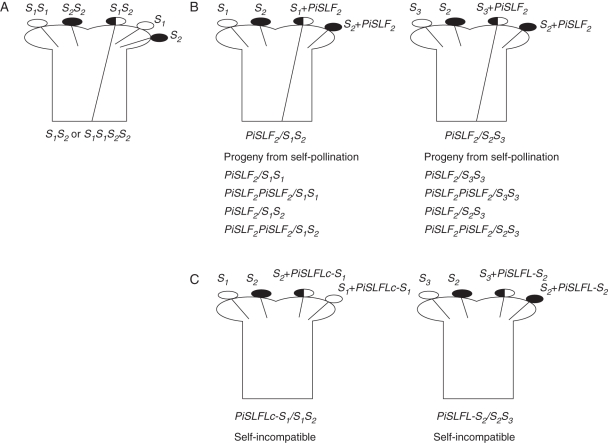Fig. 1.
Competitive interaction and its use in establishing the function of PiSLF and assessing potential function of PiSLF-like genes in SI. (A) Competitive interaction. For a diploid self-incompatible plant of S1S2 genotype, S1 and S2 pollen are rejected by the S1S2 pistil due to matching of S-haplotypes. A tetraploid plant of S1S1S2S2 genotype produces three S-genotypes of pollen and, whereas S1S1 and S2S2 pollen are rejected by S1S2 and S1S1S2S2 pistils, S1S2 (heteroallelic) pollen is not. (B) Breakdown of SI in S1S2 and S2S3 transgenic plants caused by expression of PiSLF2 in pollen. The left panel shows self-pollination of a transgenic plant PiSLF2/S1S2. The plant produces four different genotypes of pollen and, based on inheritance of the PiSLF2 transgene and the S-genotypes in the progeny, only S1 pollen carrying the PiSLF2 transgene was accepted by the pistil. The right panel shows self-pollination of a transgenic plant PiSLF2/S2S3. Progeny analysis suggests that the PiSLF2 transgene caused breakdown of SI in S3 pollen, but not in S2 pollen. That PiSLF2 caused breakdown of SI in S1 and S3 pollen, but not in S2 pollen, is consistent with the prediction made by competitive interaction, that pollen carrying two different S-alleles fails to function in SI. (C) Testing potential function of PiSLF-like genes. The left panel shows self-pollination of an S1S2 transgenic plant carrying the S1-allele of a PiSLF-like gene, PiSLFLc. The transgenic plant remained self-incompatible, suggesting that PiSLFLc-S1 did not cause breakdown of SI in S2 pollen. The right panel shows self-pollination of an S2S3 transgenic plant carrying the S2-allele of either PiSLFLb or PiSLFLd (labelled as PiSLFL-S2). The resulting transgenic plants remained self-incompatible, suggesting that neither PiSLFLb-S2 nor PiSLFLd-S2 caused breakdown of SI in S3 pollen.

